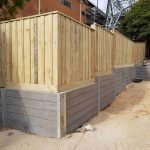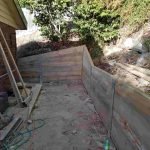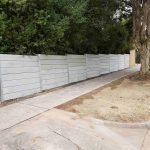Introduction
When it concerns landscaping, few tasks can raise the visual and functional value of your home quite like a well-constructed retaining wall. These structures not only prevent soil erosion however likewise produce tiered gardening areas, improve drain, and supply a solid foundation for different landscaping components. However, many property owners overlook one vital aspect that can significantly affect their retaining wall installation strategy: weather conditions In this short article, we will dig deep into The Impact of Weather condition on Your Retaining Wall Setup Plan, checking out how rain, snow, temperature level changes, and other weather-related aspects can influence the option of products-- such as timber sleeper or concrete sleeper walls-- and the general success of your project.
Understanding Retaining Walls
What is a Keeping Wall?
A retaining wall is a structure designed to keep back soil and rock from a structure or landscaped area. They can be built from various products including timber sleepers, concrete blocks, H beams, and stone. Each type has its benefits and drawbacks depending upon area, climate, and desired use.
Why Usage Retaining Walls?
Retaining walls serve several purposes:
- Soil Disintegration Control: Avoids soil from removing during rain. Elevation Management: Creates terraces in sloped areas. Aesthetic Appeal: Improves landscape design.
Types of Keeping Walls and Their Weather Resilience
Timber Sleeper Walls
Timber sleeper retaining walls contractor walls are aesthetically pleasing and offer excellent drain but may suffer in severe weather conditions. They are susceptible to rot if not treated properly.
Concrete Sleeper Walls
Concrete sleeper walls are robust and resistant to different weather. They provide outstanding toughness however can be more pricey compared to lumber alternatives.
H Beam Structures
H beam keeping walls are engineered for heavy loads. They're long lasting however need expert installation to guarantee they endure adverse weather effects.
The Effect of Weather condition on Your Retaining Wall Installation Plan
Weather is an unforeseeable element that can significantly affect your retaining wall's durability and efficiency. For instance:
- Heavy Rainfall: Can trigger soil saturation leading to increased pressure against the wall. Temperature Fluctuations: Extreme heat or cold can lead to material growth or contraction. Snow Accumulation: Heavy snow loads can put additional stress on the wall structure.
Humidity Levels
High humidity impacts wood materials like lumber sleepers significantly. It results in swelling which may compromise the integrity of the wall over time.
Wind Load Considerations
In areas prone to high winds, retaining walls need to be designed with adequate support group in location to avoid structural failure.
Planning for Seasonal Changes
Spring Considerations
Spring frequently brings heavy rains that can erode freshly installed walls if proper drain isn't considered during installation.

Summer Installations
Summer uses ideal conditions for setting up concrete sleeper walls due to lower chances of rain; however, extreme heat might require additional preventative measures throughout curing processes.
Autumn Challenges
Autumn leaves can clog drain systems if not frequently maintained following setup; this might develop waterlogged conditions harmful to wall stability.
Winter Preparations
Winter presents special difficulties such as freezing temperatures affecting the curing process for concrete installations. Appropriate preparation is important here!
Material Selection Based upon Climate
The climate where you live greatly affects material option:
|Material|Suitability|Weather condition Effect|| -------------------|---------------|------------------------|| Timber Sleeper|Moderate|Prone to rot|| Concrete Sleeper|High|Resilient under stress|| H Beam|Very High|Requires professional input|
Drainage Solutions for Various Weather Conditions
Effective drain is essential for keeping the stability of any retaining wall:
French Drains: Ideal for rerouting water away from walls. Weep Holes: Enable trapped water behind walls to escape. Gravel Backfill: Promotes drainage while providing stability.Best Practices for Setting up Retaining Walls in Numerous Climates
Conduct comprehensive site assessments before installation. Choose suitable materials based upon regional weather condition patterns. Ensure appropriate drainage options are carried out throughout construction. Schedule setups during favorable weather conditions whenever possible.Common Errors in Retaining Wall Installations Related to Weather
Ignoring local weather patterns typically leads homeowners into risks such as:

- Using improper materials Failing to consist of sufficient drainage Poor timing related to seasonal weather condition changes
Expert Insights on Seasonal Weather Condition Impacts
Professional landscapers emphasize that comprehending regional climate patterns considerably influences job success rates:
"You can't manage the weather condition, but you can certainly prepare around it," says John Smith, a professional landscaper with over 15 years of experience.
The Function of Soil Key In Weather Resilience
Different soil types react in a different way under various weather conditions:
Clay soils maintain water resulting in greater pressure versus walls. Sandy soils drain rapidly minimizing pressure however may need more frequent maintenance.Case Research studies: Successful Retaining Wall Projects
Project One: Coastal Location with High Winds
In a seaside area understood for strong winds and salty air:
- A concrete sleeper wall was picked due to its strength versus harsh elements.
Project Two: Mountainous Surface with Heavy Snowfall
In a mountainous area:
- An H beam system was used due to its ability to bear heavy loads arising from snow accumulation without jeopardizing structural integrity.
FAQs About Weather condition Influence on Maintaining Walls
How does rain impact retaining wall installation?- Heavy rain triggers soil saturation which increases pressure versus the wall, running the risk of failure if not represented during design.
- While possible, it's necessary that they are dealt with adequately and proper drain measures are employed.
- Ideally between 50 ° F (10 ° C) and 90 ° F (32 ° C) for optimum curing times without running the risk of freeze damage or fast evaporation.
- Yes! Styles using H beams frequently offer higher stability versus wind forces compared to conventional methods.
- Regularly inspect drainage systems; clear particles from weep holes; examine for signs of wear or movement post severe weather condition events.
- Timber sleepers initially appear cheaper however may sustain greater long-term costs due to upkeep concerns connected to rot in damp climates compared with concrete options.
Conclusion
In summary, comprehending The Effect of Weather Condition on Your Retaining Wall Installation Plan can not be undervalued when embarking on this important landscaping job. From picking ideal materials like timber sleeper versus concrete sleeper alternatives customized specifically toward your local climate conditions-- to guaranteeing correct drainage services are incorporated throughout building-- every decision matters significantly! So whether you're working directly with professionals or taking a DIY method, always keep those ever-changing weather condition patterns at the forefront of your preparation process! Keep in mind-- the best-laid strategies consider all possibilities!
